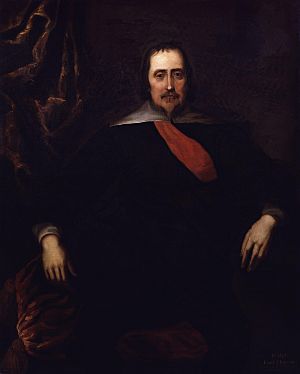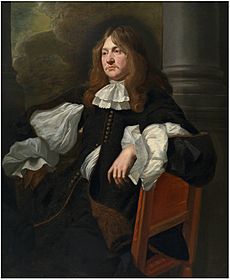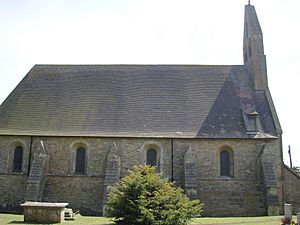Ralph Hopton, 1st Baron Hopton facts for kids
Quick facts for kids
The Lord Hopton
|
|
|---|---|

Sir Ralph Hopton, Baron Stratton
|
|
| Member of Parliament for Wells |
|
| In office 1640–1642 |
|
| Member of Parliament for Somerset |
|
| In office 1640–1640 |
|
| Member of Parliament for Bath |
|
| In office 1625–1626 |
|
| Member of Parliament for Shaftesbury |
|
| In office 1623–1625 |
|
| Personal details | |
| Born | 1596 Witham Friary, Somerset, England |
| Died | 28 September 1652 (aged 56) Bruges |
| Cause of death | Ague |
| Resting place | St Mary, Witham Friary |
| Spouse | Elizabeth Capel (1596-1646) |
| Relations | Sir Arthur Hopton (1588-1650) |
| Parents | Robert Hopton and Jane Kemys |
| Alma mater | Lincoln College, Oxford |
| Occupation | Politician, soldier and landowner |
| Awards | Order of the Bath |
| Military service | |
| Allegiance | |
| Years of service | 1620 to 1625, 1639 to 1646 |
| Rank | Major General |
| Commands | Commander, Royalist Western Army 1643-1646 |
| Battles/wars | Bohemian Revolt 1620-1621 Palatinate 1622-1623 Siege of Breda Wars of the Three Kingdoms Braddock Down; Stratton; Lansdowne; Roundway Down; Cheriton; Torrington |
Ralph Hopton, 1st Baron Hopton (1596 – 28 September 1652) was an English politician and soldier. He became a Baron in 1643. During the First English Civil War, he was a leader for the Royalist side in the West Country of England.
He was a close friend and advisor to Edward Hyde, 1st Earl of Clarendon. He also advised the future King Charles II. Hopton led the last important Royalist army. After his army surrendered in 1646, he went into exile. He was a strong supporter of the Church of England. He did not like Catholicism or Presbyterianism. He died in Bruges in 1652.
Edward Hyde, who wrote about the war, said Hopton was 'a man of great honour, integrity, and piety'. He also said Hopton had 'great courage and industry'. He was an excellent officer for any command, but not the very top one.
Contents
Early Life and Family
Ralph Hopton was born in early 1596. He was baptised on March 13 at St Peter's Church in Evercreech. He was the oldest child of Robert Hopton (1575-1638) and Jane (née Kemys, around 1570-1610). His mother's family owned land in Monmouthshire.
His grandfather had sold family lands in Suffolk to help his ten daughters get married. So, Robert inherited Witham Friary in Somerset. This land had belonged to Glastonbury Abbey before it was closed down in 1538.
Ralph went to a local grammar school, possibly King's School, Bruton. He also studied at Lincoln College, Oxford, like his uncle, Sir Arthur Hopton. In 1614, he studied law in London. This was a common education for men of his social standing back then.
In 1623, he married Elizabeth Capel (1596-1646). They did not have any children. His lands were later inherited by his nephew, Thomas Wyndham. Thomas was the son of Ralph's oldest sister, Catherine.
His Career and Wars
Early Military and Political Steps (1615-1642)

From 1615 to 1618, Hopton traveled around Europe. He wanted to 'learn languages'. In 1620, he joined English volunteers. They were led by Sir Horace Vere. This group went to support Frederick of the Palatinate. Frederick had just become the Protestant king of Bohemia.
King James I allowed this. His daughter, Elizabeth, was Frederick's wife. Hopton's younger sister, Abigail, was one of Elizabeth's ladies-in-waiting.
Frederick lost a battle called White Mountain in November 1620. Hopton and his friend William Waller helped the royal couple escape to safety. The Queen reportedly rode on Hopton's horse. They finally reached the Dutch Republic in early 1621.
Hopton came back to London in February. He was chosen to be a Member of Parliament, or MP, for Shaftesbury. This area was controlled by the Earl of Pembroke, who was related to Hopton's mother.
The Parliament was angry that King James did not support his sister. They focused their anger on an old Catholic lawyer, Edward Floyd. He was accused of insulting Frederick. Hopton did not like Catholics, but he argued that Floyd should have a fair hearing. Floyd was eventually released after the King stepped in.
When Parliament took a break in June, Hopton joined a military group. He fought in the Palatinate campaign against the Catholic League. He was likely part of the English soldiers defending Frankenthal. King James ordered them to surrender in March 1623.
Back in England, he married Elizabeth Capell. She was five years older and a widow. Even though they had no children, their marriage was happy. In 1624, he was asked to be an MP for Somerset, but he said no. Instead, he joined an English force. This group was trying to help Breda, which was under attack by the Spanish. They arrived in the Dutch Republic in February 1625. The group was in a very bad state. The plan failed, Breda surrendered, and Hopton went home in July.
While he was away, Hopton became an MP for Bath. He replaced Nicholas Hyde, who moved to Bristol. Nicholas Hyde was the uncle of Edward Hyde, who would become the Earl of Clarendon. This connection links Hopton to the people who wanted a king who ruled with Parliament. They were against King Charles I trying to rule without Parliament. But they still supported him when the Civil War started in 1642.

During the Anglo-Spanish War (1625-1630), Hopton refused to join a military trip to Cádiz. He correctly guessed it would fail because there wasn't enough money. He became a Knight of the Bath in February 1626. He was chosen as MP for Wells in 1628. The next year, King Charles closed Parliament. He did not call it again until 1640.
Hopton became a Deputy lieutenant for Somerset and a Justice of the Peace. He inherited his father's lands in 1638. He stayed out of the political arguments of the 1630s. But he supported the collection of Ship money, a tax for the navy. In 1639, he raised a group of cavalry (soldiers on horseback) to fight in the first of the Bishops Wars.
King Charles did not want to ask Parliament for money. This led to problems. Even though he gathered 15,000 men, most were untrained and unpaid. They were also armed poorly. He had to agree to the Treaty of Berwick. This left the Covenanters in charge of Scotland.
To get money for another try, Charles called Parliament in early 1640. This was known as the Short Parliament. Hopton was chosen for Somerset. But Parliament refused to give taxes without the King making some promises. So, it was closed after three weeks. Hopton did not fight in the 1640 war, which was another loss for the King. He was an MP for Wells in the Long Parliament. This Parliament was called to get money to pay the Scots to leave England.
Hopton, along with Edward Hyde and others, voted to execute the King's main advisor, the Earl of Strafford. Unlike them, he also supported the Grand Remonstrance in late 1641. This document was strongly against Catholics. Hopton was a strong supporter of the Church of England. When Archbishop Laud was arrested and bishops were removed from the House of Lords, he seemed to change sides. He defended the King's attempt to arrest five Members of Parliament in January 1642. In early March, he was held in the Tower of London for two weeks. This was because he disagreed with Parliament criticizing the King.
The English Civil War (1642-1646)
After his release in March, Hopton became a Royalist Commissioner of Array for Somerset. This meant he was in charge of the local trained bands (local militias). Even with Hopton's connections, Parliament controlled Somerset. This forced him to go to Sherborne, in Dorset. The First English Civil War began on August 22, when King Charles started his army at Nottingham.
King Charles made the Marquess of Hertford his main commander in the West. A larger Parliamentary army, led by the Earl of Bedford, threatened the Royalists. They retreated from Wells to Minehead. Hopton advised Hertford to take the foot soldiers and cannons across the water to South Wales.
Hopton, with a small group of cavalry, joined Sir Bevil Grenville and other supporters in Cornwall. Under his leadership, the Royalists won battles at Braddock Down in January 1643 and Stratton in May. After the undecided Battle of Lansdowne on July 5, he joined Hertford and Prince Maurice. Their combined forces defeated William Waller's army at Roundway Down on July 13. This was the Royalists' biggest success of the war. It secured the West Country for them, except for a few places like Plymouth.
Hopton was temporarily blinded by an explosion after Lansdowne. He was confirmed as the Royalist commander in the West. He was made Baron Hopton of Stratton and governor of Bristol. In September, it was decided that Prince Rupert would attack London. Hopton would advance into Hampshire and Sussex. These areas had iron factories that made weapons for Parliament. However, Rupert was stopped at Newbury on September 20. Although Hopton reached Winchester in November, he could not move further.
In March 1644, he was defeated at Cheriton. This ended the Royalist campaign in Southern England. It also hurt his standing with King Charles. He did serve in the Lostwithiel campaign. But his main job became managing things. In early 1645, he joined the Council advising the future King Charles II. After the Naseby in June, the Western Army was the last important Royalist fighting force. But it was defeated by the New Model Army at Langport in July.
Hopton took over from Lord Goring as commander in January 1646. But the rest of his army was defeated at Torrington on February 16, 1646. He pulled back to Truro. There, he surrendered to Thomas Fairfax on March 12.
Life After the War (1646-1652)
Along with Edward Hyde, Hopton followed the Prince of Wales to Jersey. Like most of the Prince's advisors, they refused to go with him to Paris. They were worried about the strong Catholic influence of his mother, Henrietta Maria. Hopton's wife died shortly after this. In 1647, he moved to Rouen. He stayed with his uncle, Sir Arthur Hopton, who used to be an Ambassador in Madrid.
He became an advisor to Charles II again during the Second English Civil War (1648-1649). This war continued after King Charles I was executed in January 1649. Hopton resigned after Charles II signed the Treaty of Breda in 1650. This treaty agreed to make Presbyterianism the official religion in England. In return, Scotland would help Charles II get his throne back. The Episcopalian Church of England was very important to Hopton's beliefs. He refused to support this change.
While in exile, he wrote Bellum civile. This was his own story of his military campaigns in the West from 1642 to 1644. He died in Bruges in September 1652. After the King was restored to power in 1660, his body was reburied at St Mary's, in Witham Friary in Somerset. Parliament had taken his lands in 1647. But they were returned to his family and inherited by his nephew, Thomas Wyndham.


